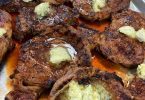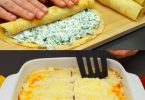1. Activate the Yeast:
In a small bowl, dissolve the active dry yeast in 100 ml of warm water (from the 375-400 ml total).
Let it sit for about 5 minutes until it becomes frothy.
2. Mix the Dough:
In a large mixing bowl, combine the bread flour and salt.
Add the yeast mixture, the remaining water, and olive oil to the flour mixture.
Mix until a sticky dough forms. If the dough is too dry, add a bit more water until the desired consistency is reached.
3. First Rise:
Cover the bowl with a clean towel or plastic wrap and let the dough rise in a warm place for 1-2 hours, or until it has doubled in size.
4. Shape the Dough:
Preheat your oven to 220°C (430°F).
Flour a work surface generously and gently transfer the dough onto it. Be careful not to deflate the dough too much.
Shape the dough into a rough rectangle by folding it over itself a few times.
Transfer the dough onto a baking sheet lined with parchment paper or a floured cloth, cover it again, and let it rest for about 30 minutes.
5. Bake:
Bake in the preheated oven for 20 minutes, or until the bread is golden brown and has a crispy crust.
To ensure a crispy crust, you can place a small pan of water at the bottom of the oven to create steam while baking.
6. Cool and Serve:
Remove the ciabatta bread from the oven and let it cool on a wire rack before slicing and serving.
Serving Suggestions
Serve with olive oil and balsamic vinegar for dipping.
Use for sandwiches or paninis.
Pair with soups or salads for a complete meal.
Cooking Tips
Ensure the water is warm but not hot to properly activate the yeast.
Handle the dough gently to maintain its airy texture.
Nutritional Benefits
Olive Oil: Provides healthy fats.
Bread Flour: Higher protein content for better gluten development.
Dietary Information
Vegetarian: Yes
Vegan: Yes
Storage Tips
Room Temperature: Store leftovers in an airtight container at room temperature for up to 2 days.
Freezing: For longer storage, wrap the bread tightly in plastic wrap and freeze for up to 1 month. Reheat in the oven before serving.
Why You’ll Love This Recipe
Simple and Budget-Friendly: Minimal ingredients and an easy process make this recipe accessible for everyone.
Airy and Crispy Texture: The perfect ciabatta with its airy interior and crispy crust.
Versatile: Ideal for sandwiches, dipping, or pairing with meals.
Conclusion
Enjoy this easy and budget-friendly ciabatta bread for a delicious and versatile addition to your meals. It’s simple to make, and the results are absolutely delightful. Whether you’re serving it with a meal or enjoying it on its own, this ciabatta bread is sure to impress. Happy baking! 💖
Frequently Asked Questions
Can I use all-purpose flour instead of bread flour?
Yes, you can use all-purpose flour, but bread flour is recommended for the best texture due to its higher protein content.
What if my dough is too sticky?
It’s normal for ciabatta dough to be sticky. If it’s too wet to handle, you can add a little more flour, but avoid adding too much as it may affect the texture.
Can I let the dough rise overnight?
Yes, you can let the dough rise overnight in the refrigerator. Just bring it to room temperature before shaping and baking.
Do I need a special pan to bake ciabatta?
No special pan is needed. A regular baking sheet lined with parchment paper works perfectly.
Can I add herbs or other flavors to the dough?
Absolutely! You can add fresh or dried herbs, garlic, or olives to the dough for extra flavor.
How do I know when the ciabatta is fully baked?
The bread should be golden brown and have a hollow sound when tapped on the bottom. The internal temperature should be around 90°C (195°F).
Can I double the recipe?
Yes, you can double the ingredients to make two loaves. Be sure to divide the dough evenly before the second rise.
What if I don’t have active dry yeast?
You can use instant yeast. The process is the same, but instant yeast doesn’t need to be activated in water beforehand.
How can I make the crust even crispier?
Creating steam in the oven by placing a pan of water at the bottom or spraying water into the oven during the first few minutes of baking can help achieve a crispier crust.
Can I use a bread machine to knead the dough?
Yes, you can use a bread machine on the dough setting. Just follow the machine’s instructions, and then shape and bake the dough as directed.
ADVERTISEMENT






